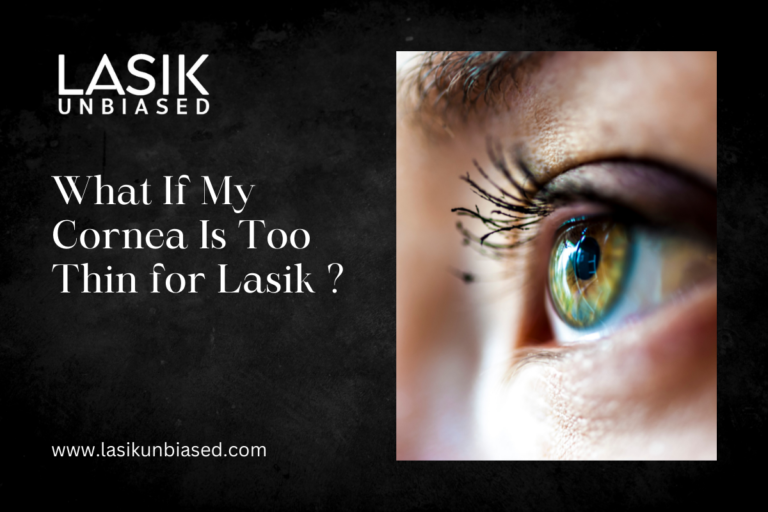What If My Cornea Is Too Thin for LASIK?
LASIK (Laser-Assisted in Situ Keratomileusis) is one of the most popular and effective procedures for correcting vision problems such as nearsightedness (myopia), farsightedness (hyperopia), and astigmatism. It offers a life-changing solution for people looking to reduce their dependence on glasses or contact lenses. One of the key factors determining eligibility is the cornea’s thickness.
The cornea, the transparent, dome-shaped surface that covers the front of the eye, plays a vital role in focusing light. LASIK uses a laser to reshape the cornea to improve vision. But what happens if your cornea is too thin for the procedure? Let’s explore this situation in more detail, understand the risks, and look at alternatives.
Why is Corneal Thickness Important for LASIK?
Before diving into alternatives, it is essential to understand why corneal thickness is a critical factor in LASIK eligibility. During LASIK, the surgeon uses a laser to reshape the cornea to correct vision problems. This involves creating a thin flap in the cornea and then removing a small amount of tissue beneath the flap to reshape the cornea.
If the cornea is too thin, removing tissue can make the cornea weaker and increase the risk of complications, such as:
- Corneal Ectasia: A condition where the cornea becomes weak and starts bulging outward, leading to a distorted vision.
- Reduced Stability: A thinner cornea may not provide the necessary strength and stability for the eye post-surgery.
- Increased Risk of Infection: Thinner corneas may be more prone to complications, including infections.
Therefore, if your cornea is too thin, your eye surgeon may advise against LASIK due to these potential risks.
How is Corneal Thickness Measured?
Corneal thickness is typically measured during a pre-operative eye examination. The procedure used to measure corneal thickness is called pachymetry, which can be done with either ultrasound or optical coherence tomography (OCT). A healthy cornea typically measures between 500 and 600 micrometres in thickness. Still, for LASIK to be safe and effective, the cornea must usually be at least 480 micrometres thick after the necessary reshaping.
What if My Cornea is Too Thin for LASIK?
If your cornea is too thin for LASIK, don’t worry! Although LASIK may not be the right option, other alternatives can help improve your vision. Let’s take a look at some of these options.
Alternatives to LASIK for Thin Corneas
1. PRK (Photorefractive Keratectomy)
PRK is a laser eye surgery similar to LASIK but without a corneal flap. In PRK, the surgeon removes the outer layer of the cornea (the epithelium) and then uses a laser to reshape the underlying tissue to improve vision. This technique is an excellent option for individuals with thinner corneas because it doesn’t involve creating a flap, which reduces the risk of corneal weakness.
PRK has a longer recovery time than LASIK, as the epithelium must regenerate. However, it is a proven and safe procedure for people with thinner corneas.
2. LASEK (Laser-Assisted Subepithelial Keratectomy)
LASEK is another alternative to LASIK and is very similar to PRK. The main difference is that in LASEK, the epithelium is loosened with an alcohol solution, and then the laser is used to reshape the cornea. The epithelium is then repositioned over the treated area. Like PRK, LASEK is ideal for people with thin corneas, as no corneal flap is involved.
The recovery period for LASEK can be more extended than for LASIK, and the post-surgery discomfort is often more pronounced in the early stages. However, it is an excellent alternative for individuals who may not be candidates for LASIK due to corneal thickness.
3. SMILE (Small Incision Lenticule Extraction)
SMILE is a newer type of laser eye surgery and is often considered a more advanced alternative to LASIK. Instead of creating a flap, SMILE uses a laser to make a small disc-shaped piece of tissue (called a lenticule) inside the cornea, which is then removed through a tiny incision. Because this procedure doesn’t involve creating a flap, it is gentler on the cornea and may be suitable for people with thin corneas.
SMILE has several advantages over LASIK, including a smaller incision, faster recovery time, and potentially less risk of complications such as dry eyes. While SMILE is not as widely available as LASIK, it is increasingly gaining popularity for patients with thinner corneas.
4. Corneal Cross-Linking (CXL)
Corneal cross-linking can be a viable treatment option for patients with corneal thinning due to conditions such as keratoconus (a condition where the cornea becomes thin and bulges into a cone shape). This procedure strengthens the cornea by using ultraviolet light and riboflavin (vitamin B2) to enhance the bonds between collagen fibres in the cornea.
While corneal cross-linking is not a vision correction surgery like LASIK, it can help stabilize a thin cornea and prevent further thinning or bulging. This treatment can sometimes be combined with other refractive surgeries to improve vision in patients with thin or weakened corneas.
5. Implantable Contact Lenses (ICLs)
If you have thin corneas and are not a candidate for LASIK or other laser-based treatments, implantable contact lenses (ICLs) may be a suitable option. ICLs are surgically placed inside the eye, between the iris and the natural lens, to correct refractive errors. Unlike LASIK or PRK, ICLs do not involve reshaping the cornea, making them an excellent option for individuals with corneal irregularities or insufficient thickness.
ICLs can provide excellent vision correction with little risk of complications and are reversible if necessary. They also offer advantages for people with high prescriptions who may not be candidates for traditional laser procedures.
Don’t be discouraged if your cornea is too thin for LASIK surgery. Multiple alternative vision correction options are available, including PRK, LASEK, SMILE, corneal cross-linking, and implantable contact lenses (ICLs). Consulting with an experienced ophthalmologist or refractive surgeon is essential to determine which option is best for your specific needs and eye health.
It’s important to remember that the goal of any vision correction procedure is to improve your quality of life. Some solutions can help you see clearly and comfortably without needing glasses or contact lenses, regardless of corneal thickness. You can achieve your vision goals and enjoy a brighter future with the proper guidance and treatment.


